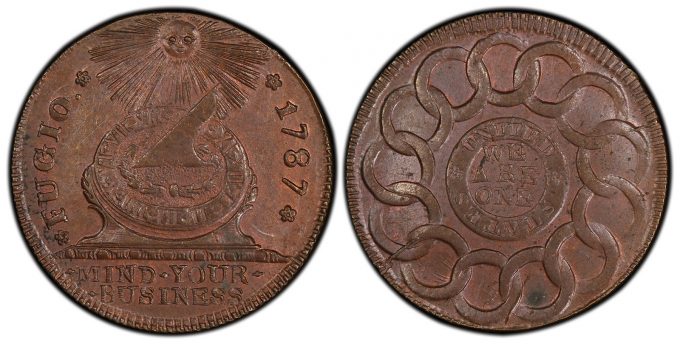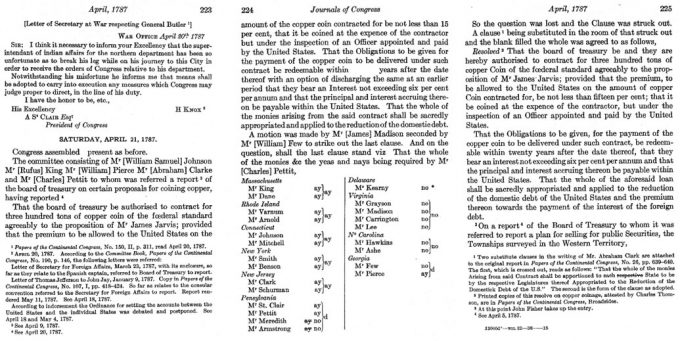The Fugio Cent has long been one of the most enjoyed early American collectibles, and now numismatists can count it as the earliest of all United States regular-issue coins.

Professional Coin Grading Service (www.PCGS.com) is announcing the groundbreaking reclassification after an exhaustive study carried out by a team of leading numismatic experts including John Dannreuther, Gordon Wrubel, Craig Sholley, Brian Greer, Chuck Link, Tony Terranova, Chris Victor-McCawley, David McCarthy, and Erik Goldstein.
"The Fugio Cent is one of the most popular coins from the early Federal period, so it’s a big deal when new research sheds enough light to completely reshape the hobby’s understanding of an iconic coin like this," says President of Professional Coin Grading Service Stephanie Sabin. "By officially recognizing the Fugio Cent as a regular-issue circulating coin based on the overwhelming evidence presented by our numismatic experts, we help enhance the hobby’s understanding of this important coin and its foundational role in the early United States monetary system."
PCGS Director of Numismatic Education and Grading Team Leader Steve Feltner is intrigued at how much information lay beneath the surface of such widely studied and collected coins like the Fugio Cent.
"Fugio Cents, long lumped into the same colonial class as New Jersey Coppers, Nova Constellatio Coppers, and Massachusetts Cents, are finally going to get the numismatic credit that they have deserved for nearly two and a half centuries!"
Feltner says the decision to reclassify the status of the Fugio Cent wasn’t something to be taken lightly.
"When I was first approached about the idea of reclassifying Fugio coppers as Fugio Cents, I will admit I was skeptical. So much has been studied and written about them in the past that I couldn’t imagine anything warranting a change." He concludes, "I was wrong."
Adds Feltner, "The research and historical backing that was presented to me and my colleagues at PCGS was irrefutable. There were several times during the initial read-through that I caught myself saying, ‘that makes sense.’ It was an experience that I will never forget."
Among the evidence warranting the reclassification of the Fugio Cent as a regular-issue coin is a measure passed by the Board of Treasury on April 21, 1787, noting that the Fugio Cents were to be "of the federal standard" per weight standards stipulated in the 1786 report for United States gold, silver, and copper coins. As part of these standards, cents were to contain 157.5 grains of pure copper. So, when Congress authorized the contract for Fugio Cents on this date, the intent was to produce coins that were needed in commerce.

The reclassification of the Fugio Cent as a regular-issue coin isn’t the first time PCGS has led the way in properly recognizing coins that may have been numismatically miscategorized in the past. Years ago, PCGS was the first grading service to classify 1792 Half Dismes, once listed among pattern coins, as regular issues. A Guide Book of United States Coins ("The Red Book") and others soon followed suit.
The reclassification of the Fugio Cent means PCGS will list them among regular-issue coinage, under the heading of "Federal Contract Coinage," and they will retain their position among PCGS Colonial Registry Sets. Read the January/February issue of the PCGS Rare Coin Market Report for the full story on why PCGS is reclassifying the Fugio Cent as a regular-issue coin. For more information about the PCGS Set Registry, please visit https://www.pcgs.com/setregistry.
About Professional Coin Grading Service
Professional Coin Grading Service (PCGS) is a third-party coin and banknote grading company that was launched in 1986. Over 35 years, PCGS has examined and certified more than 48 million U.S. and world coins, medals, and tokens with a combined value of over $47 billion. For more information about PCGS products and services, including how to submit your coins for authentication and grading, please visit www.PCGS.com or call PCGS Customer Service at (800) 447-8848.






So I guess the difference is do you care if US coins were made directly by the US government (as the mint starting issuing in 1793), or under contract as with these fugio cents. splitting hairs on whether it is ‘US-manufactured’ or ‘US-authorized’.
Cook Islands coins for everyone! \O/ 🙂